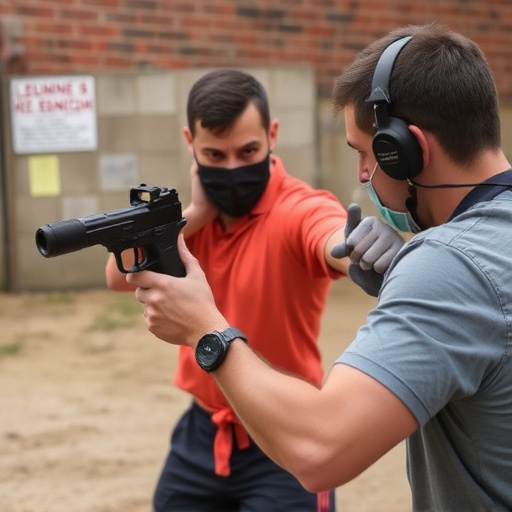Regular monthly maintenance is essential for keeping stun guns reliable and safe. This includes cleaning, testing charge and functionality, inspecting for damage or wear, and caring for batteries. Proper storage and adherence to manufacturer guidelines further reduce risk of accidental discharge. Incorporating training and practice drills alongside maintenance ensures optimal performance in emergency situations.
“Uncover the intricacies of stun gun safety with our comprehensive review. From understanding the mechanics behind its jolting power to mastering safe storage practices, this guide is your go-to for optimal self-defense preparation. Learn about regular visual and functional inspections, crucial for identifying any potential issues. Discover efficient cleaning techniques and battery care tips to ensure longevity. Moreover, explore effective training drills to familiarize yourself with the device’s operation. Embrace proactive stun gun maintenance with our monthly guidelines for ultimate peace of mind.”
- Understanding Stun Gun Mechanics and Safety Features
- Monthly Inspection: Visual and Functional Checks
- Cleaning and Maintenance Tips for Optimal Performance
- Battery Care and Replacement Guidelines
- Safe Storage Practices to Prevent Accidental Discharges
- Training and Practice Drills for Effective Self-Defense
Understanding Stun Gun Mechanics and Safety Features

Stun guns, also known as electric sting devices, operate on a simple yet powerful principle: delivering a strong electrical current to incapacitate an assailant temporarily. Understanding their mechanics is crucial for safe and effective use. Inside the stun gun, there’s a high-voltage, low-amperage power source connected to one or more electrodes. When the trigger is pulled, this energy is discharged through the electrodes towards the target, causing muscle contractions, pain, and temporary paralysis.
Regular stun gun monthly maintenance tips are essential to ensure reliability and safety. This includes keeping the device clean and free from debris, regularly testing the charge and functionality, and inspecting for any signs of damage or wear. Proper care not only extends the lifespan of your stun gun but also ensures it’s ready to protect you when needed. Remember, a well-maintained stun gun is a critical tool for personal safety, providing peace of mind in uncertain situations.
Monthly Inspection: Visual and Functional Checks

Regular maintenance is crucial for ensuring your stun gun remains reliable and safe to use. One essential aspect of this process is conducting a thorough monthly inspection, covering both visual and functional checks. Begin by examining the device for any signs of physical damage, such as cracks or dents in the body, which could indicate potential failure points. Check all moving parts, including triggers and safety switches, for proper functionality and smooth operation.
During this time, pay special attention to the battery level, ensuring it is at an optimal charge. Stun guns rely on functional batteries to deliver a powerful electric shock, so keeping them well-maintained will ensure your device performs when needed. Also, inspect the stun gun’s exterior for any signs of wear and tear, especially in areas prone to contact with sweat or water, as these elements can impact performance and safety.
Cleaning and Maintenance Tips for Optimal Performance

Regular cleaning and maintenance are essential for ensuring optimal performance and longevity of your stun gun. To maintain its effectiveness, it’s recommended to wipe down the device with a soft, damp cloth after each use, removing any visible dirt or debris. Avoid using harsh chemicals or abrasive materials, as these can damage the surface and compromise the stun gun’s safety mechanism.
For more thorough monthly maintenance, disassemble the stun gun following the manufacturer’s instructions. Use compressed air to blow out any dust or particles from internal components, taking care not to dislodge them. Ensure all parts are thoroughly dried before reassembling. Additionally, periodically inspect the device for any signs of wear and replace any worn-out parts promptly to maintain safety standards and optimal functionality.
Battery Care and Replacement Guidelines

Maintaining your stun gun involves more than just regular cleaning; battery care and replacement are crucial components of its safety mechanism. It’s recommended to perform monthly maintenance checks, including inspecting the device for any signs of damage or corrosion. Ensure the battery is in good condition and replace it promptly if it shows any wear or leakage. Stun guns typically use non-rechargeable batteries, so keeping a spare on hand is advisable.
When replacing the battery, follow the manufacturer’s guidelines carefully. Use only approved replacement batteries designed for your specific model to maintain optimal performance and safety. Regularly testing the stun gun after battery changes ensures it remains operational, providing peace of mind in case of an emergency. These simple steps contribute to the overall reliability and longevity of your stun gun, making it a valuable tool for personal safety.
Safe Storage Practices to Prevent Accidental Discharges

Stun guns, despite their purpose for self-defense, can pose risks if not stored and maintained properly. One of the primary safety concerns is accidental discharge, which can be mitigated through stringent storage practices. It’s recommended to keep stun guns out of reach of children and unauthorized individuals by securing them in a locked box or safe. Additionally, storing them away from heat sources, direct sunlight, and moisture can prevent damage and ensure optimal functionality. Regularly checking the device for any signs of wear or malfunction is crucial, as well as keeping the contact points clean to maintain reliable performance.
Monthly maintenance plays a significant role in stun gun safety. This includes examining the device for any loose parts or damage, ensuring the trigger mechanism functions smoothly, and verifying that the stun gun’s charge remains at an effective level. Following manufacturer guidelines for charging and storage can significantly reduce the risk of accidental discharge. These simple practices not only maintain the integrity of your stun gun but also ensure it’s ready when needed, making them essential components of responsible ownership.
Training and Practice Drills for Effective Self-Defense

Regular training and practice drills are essential components of mastering self-defense with a stun gun. These sessions should cover various scenarios, from basic grip and activation techniques to more advanced tactical moves. It’s crucial to simulate real-life situations during training to prepare for unexpected encounters. Practice firing at different angles, distances, and targets, including moving objectives, to ensure effectiveness under stress.
Incorporating monthly maintenance tips into your routine is equally vital. This includes cleaning the stun gun thoroughly, checking battery levels, and ensuring all components are in optimal condition. Regular care not only maintains the device’s performance but also allows for familiarization with its mechanics, further enhancing your ability to deploy it accurately during an emergency.
A stun gun, when properly maintained, can serve as a valuable self-defense tool. Implementing regular monthly inspections, thorough cleaning, and diligent battery care ensures optimal performance. Safe storage practices and continuous training further minimize the risk of accidental discharges, maximizing its effectiveness as a personal safety device. Remember, proper maintenance is key to ensuring your stun gun remains a reliable resource when it matters most. For comprehensive stun gun monthly maintenance tips, follow these guidelines to keep your device in top condition.
